
Workington is a coastal town and civil parish at the mouth of the River Derwent on the west coast in Cumbria, England. At the 2011 census it had a population of 25,207.
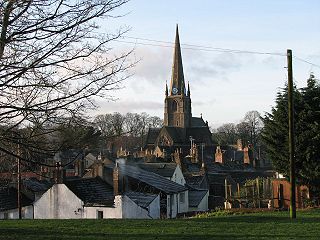
Cockermouth is a market town and civil parish in the Cumberland unitary authority area of Cumbria, England, so named because it is at the confluence of the River Cocker as it flows into the River Derwent. The mid-2010 census estimates state that Cockermouth has a population of 8,204, increasing to 8,761 at the 2011 Census.
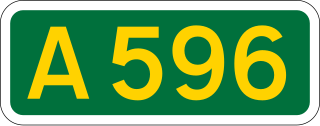
The A596 is a primary route in Cumbria, in northern England, that runs between Thursby and Workington. For its entirety the A596 parallels the A595, and meets the A595 at both ends. The A596 begins its course at a roundabout junction with the A595 at Thursby, before continuing past the towns of Wigton and Aspatria. As it travels further towards the coast, it reaches the town of Maryport, where there is a junction to the B5300 heading up the coast to Silloth via Allonby, Mawbray, and Beckfoot. It then crosses over the River Derwent, skirting the eastern edge of Workington shortly before terminating at the junction with the A595 at Lillyhall.
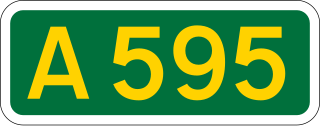
The A595 is a primary route in Cumbria, in Northern England that starts in Carlisle, passes through Whitehaven and goes close to Workington, Cockermouth and Wigton. It passes Sellafield and Ravenglass before ending at the Dalton-in-Furness by-pass, in southern Cumbria, where it joins the A590 trunk road. The road is mostly single carriageway, apart from in central Carlisle, where it passes the castle as a busy dual carriageway road named Castle Way, and prior to that as Bridge Street and Church Street, where it passes close to the McVitie's or Carr's biscuit factory. The Lillyhall bypass is also dual carriageway.

Cumbria Constabulary is the territorial police force in England covering the unitary authority areas of Cumberland and Westmorland and Furness in the ceremonial county of Cumbria. As of September 2017, the force had 1,108 police officers, 535 police staff, 93 police community support officers, and 86 special constables.

Workington railway station is a railway station serving the coastal town of Workington in Cumbria, England. It is on the Cumbrian Coast Line, which runs between Carlisle and Barrow-in-Furness. It is owned by Network Rail and managed by Northern Trains.

Workington Town is a semi-professional rugby league club based in Workington, West Cumbria, England. The club plays home games at Derwent Park and competes in the League One, the third tier of British rugby league.
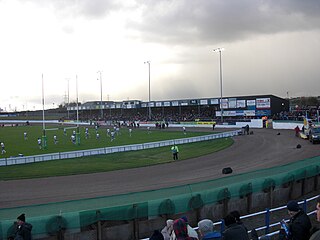
Derwent Park is a Rugby League Stadium and former motorcycle speedway in Workington, England situated beside the Cumbrian River Derwent. It is used mostly for rugby league matches and is the home stadium of Workington Town who play in League 1 the 3rd tier of the British rugby league system. Derwent Park has a capacity of 12,000 people with 1,200 seats and the pitch is surrounded by a 398 yards motorcycle speedway track.
The Cockermouth & Workington Railway was an English railway company which built and operated a railway between the Cumberland towns of Workington and Cockermouth. The railway opened for service in 1847, and ran from the Whitehaven Junction Railway station at Workington to a station at Cockermouth near the bridge over the Derwent. A single-tracked line of eight and a half miles length, its revenue came largely from the transport of coal from the pits of the lower Derwent valley to the port at Workington for shipment by sea. The Marron extension of the Whitehaven, Cleator and Egremont Railway and the Derwent Branch of the Maryport and Carlisle Railway were both constructed to link with the C&WR and together give an alternative route for the northward movement of haematite ore from the Cumberland ore-field. The completion of the Cockermouth, Keswick and Penrith Railway made the C&WR part of a continuous through route between South Durham and the Cumberland orefield. These developments both improved the potential profitability of the C&WR, and made control of it important to bigger companies wishing to maximise the iron-ore traffic over their lines: the C&WR was absorbed by the London and North Western Railway in 1866.
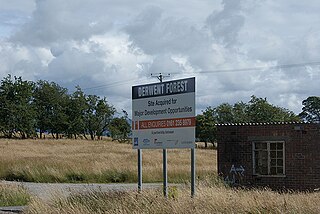
RNAD Broughton Moor is a decommissioned Royal Naval Armaments Depot located between Great Broughton and Broughton Moor in the County of Cumbria, England.

Rowrah is a village in Cumbria, England, and spans the civil parishes of Arlecdon and Frizington and Lamplugh. The majority of Rowrah is within Arlecdon and Frizington. The parish boundaries are formed from the Windergill Beck and Colliergate Beck: as such nine properties, Rowrah Hall Farm, Rowrah Hall, Ainsdale House, Rowrah Head, four properties on Pheasants Rise and Rowrah Station technically fall within Lamplugh.

Great Broughton railway station briefly served the village of Great Broughton, near Cockermouth in Cumberland, England.

The 2009 Great Britain and Ireland floods were a weather event that affected parts of Great Britain and Ireland throughout November and into December 2009. November was the wettest month across the United Kingdom since records began in 1914 and had well above average temperatures. The worst affected area in Great Britain was the English county of Cumbria. The Irish counties of Clare, Cork, Galway and Westmeath were among the worst affected areas of Ireland.

Workington North railway station was a temporary railway station in Cumbria, United Kingdom, constructed following floods which cut all road access to Workington town centre from north of the River Derwent. The station was located 1 mile (1.6 km) north of Workington station on the Cumbrian Coast Line.
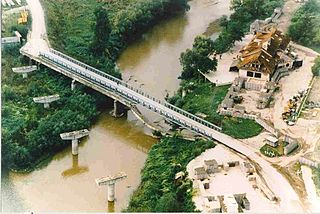
The Mabey Group is a British-based group of engineering companies, which specialises in steel fabrication, plant hire and construction products. It was initially established by Guy Mabey as a building supplies business in 1923, and expanded into engineering work, particularly bridging, under the leadership of his son, Bevil Mabey, after World War II. In the early 21st century, it was implicated in bribery scandals over corrupt payments to win contracts in countries including Iraq, Jamaica and Ghana. It sold its bridge business in May 2019 to US-based Acrow Bridge.
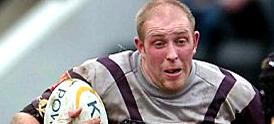
Garry John Purdham was an English professional rugby league player and farmer. He was killed in the 2010 Cumbria shootings.

Seaton railway station served the village of Seaton, near Workington in Cumberland, England.

During the twenty-four hours before Friday 20 November 2009, rainfall of over 300 mm (12 in) was recorded in Cumbria. Flooding along the Borrowdale and Derwent Valley meant that some areas were up to 8 feet (2.4 m) deep in water. The surge of water off the fells of the Lake District which flowed into Workington down the River Derwent washed away a road bridge and a footbridge. PC Bill Barker was killed when Northside Bridge collapsed. The cemetery at Camerton, historically the burial ground for the community of Seaton, was badly damaged with many gravestones being damaged or upturned.
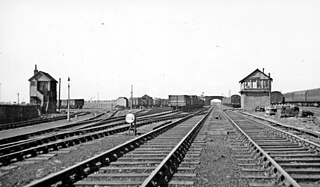
Harrington Junction was a railway junction in Harrington, Cumbria, England. It joined three branches to the Cleator and Workington Junction Railway's (CWJR) main line from Workington Central to Moor Row via Cleator Moor West. No station ever existed at the junction, High Harrington was the nearest, 48 chains (0.97 km) to the south.

Linefoot railway station, sometimes referred to as Linefoot Junction and sometimes as Linefoot Goods, briefly served the scattered community around the crossroads at Linefoot, near Cockermouth in Cumberland, England.



















